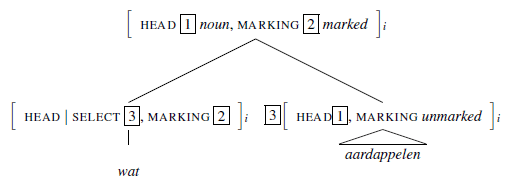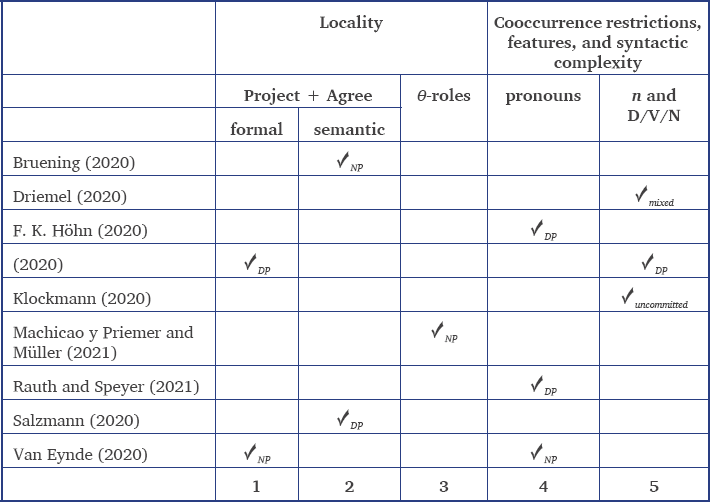1 Setting the stage
Almost1 all languages feature a nominal category and most seem to have pronouns as well. Moreover, it is well-known that a minority of languages features articles. Typological studies seek to address questions of such language universals and can inform syntactic theory. The latter is concerned with the ingredients of and relationships between hierarchically structured expressions. A highly relevant question for syntactic theorizing is whether all languages also feature a nominal phrase (NP). Finally, it is a controversial question whether all languages also feature a determiner phrase (DP). Many studies in this collection have sought to address different aspects of such questions pertaining to nominal complexes2 (NCs) exemplified by the English (1).
| (1) | the dog |
A core question for any nominal system in a given language is this: Does the DP dominate the NP, as in (2), or does the latter dominate the determiner system, as in (3)? Or is an altogether different approach required? In a DP-based approach, the functional category dominates the lexical core, while this is reversed in NP-based approaches.
| (2) | 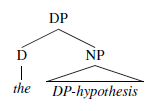 |
| (3) | 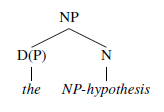 |
As of yet this elementary question has not received a conclusive answer. While NCs figure prominently in the theory of syntax, the DP- vs. NP-debate remains unresolved, despite the long success of the DP-hypothesis across theoretical frameworks (Szabolcsi 1983, Abney 1987 et seq).
Glossa’s Special Collection (SC) New perspectives on the NP/DP debate brings together nine contributions that investigate particular syntactic analyses of NCs, covering a wide and varied range of different topics. The slightly modified3 word cloud in Figure 1 is based on all abstracts of the contributions to the SC, and bears witness to the variation of approaches, themes, and topics covered.
The SC’s typological breadth is shown by the fact that it spans NC-phenomena from eleven language families as diverse as Austronesian, Bantu, Dravidian, Eskimo–Aleut, Germanic, Iroquoian, Mongolic, Romance, Slavic, Turkic and Uralic. The papers in the SC examine seventeen languages including Bosnian-Serbo-Croatian, Dutch, English, French, German, Italian, Hungarian, Mohawk, Mongolian, Niuean, Polish, Romanian, Shona, Spanish, Tamil, Turkish and Yupik Eskimo. In addition, the SC contains a typological survey of the adnominal pronoun construction in 81 languages (Höhn 2020), with some overlap with the previously mentioned ones. In addition to cross-linguistic comparison and investigation, the SC presents an inquiry into intra-linguistic variation, by delving into intricacies of determiner and reinforcer system of the German dialect Rhine and Moselle Franconian (Rauth & Speyer 2021). This study also sheds light on diachronic aspects of NC-properties. The papers in the volume make use of different methodologies: corpus studies, field work (broadly construed: data elicitation interviews), and conventional introspective judgments. Various formal syntactic frameworks are used to capture the phenomena, including Minimalist approaches in the broad sense and Head-driven Phrase Structure Grammar (HPSG).
In this introduction article, we sketch and describe the contributions to the SC in section 2. Subsequently, we will comment on the papers and situate them in broader issues of syntactic theory in section 3. Section 4 concludes the paper.
2 Contributions to the debate and beyond
This section provides summaries of the articles of the SC, starting with articles assuming the DP, followed by articles that adopt the NP approach, and ending in a subsection on approaches that elude a clear allocation. The order of the summaries follows the alphabetical order of the authors.
2.1 Contributions using a DP framework
Höhn (2020) provides a cross-linguistic survey of the adnominal pronoun construction illustrated by English (4a) in 82 languages:
| (4) | a. | we/you linguists |
| b. | *they linguists |
The paper addresses the absence of third person in the construction, as shown in (4b), and notes that “the third person gap is crosslinguistically relatively rare and may be restricted to Europe and surrounding areas.” Höhn (2020) argues that it arises as an effect of contextually conditioned allomorphy and offers a Distributed Morphology analysis, building on a DP-structure as in (5):
| (5) | 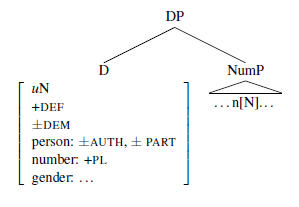 |
| (6) | a. | D[+auth, +pl] | ↔ | we |
| b. | D[–auth, +part] | ↔ | you | |
| c. | D[+def, +pl] | ↔ | they /_]φ | |
| d. | D[+def] | ↔ | the |
Following Nevins (2007; 2011), he uses the feature specifications [±auth(or)] and [±part(icipant)]. The Vocabulary Items (6a) and (6b) can be inserted as long as their feature specifications are a subset of the one on the terminal node D. (6c) and (6d) can each be inserted in definite environments. However, (6c) bears a contextual restriction, which demands that the exponent realize the right edge of its spell-out domain. Thus it will only be inserted if D’s complement is phonologically empty, successfully blocking the third person case (4b). (6d), by contrast, is the elsewhere case.
Höhn (2020) discusses pros and cons of NP-based approaches, specifically Bruening (2009) and Van Eynde (2006), neither of which addresses the adnominal pronoun construction. He evaluates options using Bruening’s nP shell analysis – or sketch thereof –, which is given in (7):
| (7) | 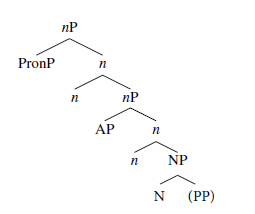 |
Under the assumption that n underlies articles in some languages, Höhn (2020) notes that the following issues arise:
“why do some languages block third person pronouns in the relevant specifier position and why would this typically correlate with the existence of an overt article? If the article corresponded to a specifier position itself, one would have to somehow ensure that articles and adnominal pronouns compete for the same specifier position (in languages like English) in order to capture their interaction. However, that alone would still not explain why pronouns can – or in the third person: have to – occur on their own, while articles cannot.”
Höhn (2020) concludes that DP-based approaches fare better in accounting for the observed cross-linguistic pattern.
Iordăchioaia (2020) considers well-known nominal constructions in English (8) and their counterparts in the languages Spanish, Rumanian, Polish and German. She develops an analysis that accounts for the similarities and differences both between the constructions and between the analogues in these languages:
| (8) | a. | John’s refusing the offer | verbal gerund |
| b. | John’s refusing of the offer | nominal gerund | |
| c. | John’s refusal of the offer | derived nominal |
One of the central observations comes from Zucchi (1993: 21) who noted that nominal gerunds and derived nominals allow for determiners to precede the noun (9a), while this is impossible for verbal gerunds, which allow only possessors to precede the gerund form (9b):
| (9) | a. | the/a/that performing/performance of the song |
| b. | John’s/*the/*a/*that performing the song |
Iordăchioaia (2020) models these and related cross-linguistic differences in terms of the presence or absence of a nominalizing layer n(P); the former, (10), underlies nominal gerunds, while the latter, (11), corresponds to verbal gerunds:
| (10) | [DP D [nExtP [nP n ( [vExtP) [vP v [ ]]]]]] |
| (11) | [DP D [vExtP vExt [vP v [ ]]]] |
This way, D is allowed or prevented to featurally interact – Agree – with n. n bears gender and number. Now if agreement between the probe on D with respect to the features gender and number is possible, this gives rise to the possibility of determiners, i.e., a construction like nominal gerunds shown in (9a). With n absent, probing by D results in failed Agree (cf. Preminger 2014), bleeding the possibility for determiners to occur, while leaving leeway for the presence of possessors as in the verbal gerund exemplified in (9b). The underlying assumption is “that lexical determiners are typically incompatible with default values. English employs the possessive in such constructions, while Spanish and Romanian use the definite determiner.”
Based on a questionnaire study, Rauth & Speyer (2021) show that the demonstrative reinforcers do/lo in Rhine (12a) and Moselle (12b) Franconian have become obligatory in demonstrative contexts. As familiar from vernacular English, the reinforcer shows up between the demonstrative and the head noun:
- (12)
- a.
- Fier
- for
- all
- all
- die
- those
- wo
- who
- unner
- under
- der
- dem
- doo
- adv
- Hitz
- heat
- stöhne
- moan
- ‘For all of those who suffer from this/that heat.’
- b.
- Er
- he
- soll
- shall
- mit
- with
- dem
- dem.dat.sg
- lo’n
- adv.dat.sg
- Woon
- car
- fohrn.
- drive
- ‘He ought to drive this/that car/wagon.’
They suggest that the diachronic change leading to this construction involved a grammaticalization process of a lexical adverb in adverbial function as in (13) via a DP-peripheral position to a functional, DP-internal head they dub Index Phrase (IndP).
- (13)
- Auserdem
- moreover
- fangd
- begins
- doo
- adv
- die
- det
- Olympiaade […]
- Olympics
- aan.
- ptcl
- ‘Moreover, the Olympic Games will begin at that time.’
Their analysis of the target of this development is shown in (14b):
| (14) | a. | den da/lo Mann |
| the da/lo man | ||
| ‘this/that man’ | ||
| b. | 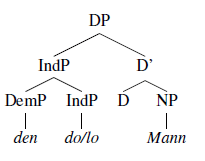 |
Rauth & Speyer (2021) identify the following problems for an NP-based analysis:
“AdvP is right-adjoined to the NP projection so that their adjacent position in pronominal use can initiate the reanalysis of do/lo as the head of IndP. However, this raises the general question whether NP is equipped with multiple specifiers which contain functional projections for all kinds of determiners, or whether NP hast just one single specifier and other determiners are adjuncts.
Another problem is how the superior NP can possibly cope with the grammaticalization when no overt noun is present.”
Rauth & Speyer (2021) argue that this is because theory-internal arguments make an NP-analysis of pronominally used demonstratives difficult.
Salzmann (2020) revisits previous arguments for the DP-hypothesis and shows that they are inconclusive. The pertinent phenomena can be recast in NP-terms, Salzmann (2020) claims. He seeks to establish “solid criteria for headedness and explore their implications” for either hypothesis. These criteria are based on assumptions, which Salzmann (2020) takes to be “largely theory-neutral,” like the assumption that “the features of the head are present on the maximal projection.”
Drawing on hybrid agreement in Bosnian-Croatian-Serbian (BCS), Salzmann (2020) argues that features on D need to function as agreement controllers, not N. As a starting point, the example (15) from BCS displays a subject-NC with a head noun vladik ‘bishop’ bearing grammatical feminine gender and biological masculine sex. The demonstrative preceding the noun concords with respect to the grammatical gender. Strikingly, the verb optionally agrees with respect to either grammatical gender or biological sex, i.e. it can be exhibit feminine or masculine agreement inflectional affixes:
- (15)
- On-e
- those-f.pl
- vladik-e
- bishop-pl
- su
- are
- me
- me
- juče
- yesterday
- posetil-e/posetil-i.
- visit.ptcp-f.pl/m.pl
- ‘Those bishops visited me yesterday.’ (Puškar 2018: 304)
The example (16) exhibits grammatical feminine gender on the adjective and semantic masculine gender on the demonstrative within the same NC. The optionality of the gender agreement on the verb vanishes; instead, agreement obligatorily targets the semantic masculine gender, i.e. the one borne by the demonstrative, while agreement with the grammatical feminine is impossible:
- (16)
- On-i
- those-m.pl
- star-e
- old-f.pl
- vladike
- bishops
- su
- are
- se
- refl
- posvadjal-i/*posvadjal-e
- argued-m.pl/argued-f.pl
- na
- on
- ulici.
- street
- ‘Those old bishops argued on the street.’
The descriptive generalization is that the gender/sex specifications on the leftmost element within the NC determine the type of gender/sex agreement that the verb can express. Moreover, there is a restriction on the “switch” from grammatical gender to biological sex from right to left, which subsequently has an effect on subject verb agreement: An NC-internal switch from grammatical gender to biological gender is possible, while the reverse is impossible. Taking examples (15) and (16) as a model, [DEMF [AM NF]] is ungrammatical. It follows that once biological sex is established within the NC, the verb has no choice but to agree in biological sex, as (16) shows.
Salzmann uses a DP-structure for BCS4 and assumes that demonstratives are instances of D. He proposes that a probing grammatical gender feature is simplex: [*gen:□*]. By contrast, a probing biological gender feature is complex, featuring animacy in addition: [[*gen:□*][*anim:□*]]. Moreover, the noun bears the corresponding simplex or complex target features. Considering the DP-analysis first, the simplex and complex probing features can be borne by V, D and A alike and in any order, resulting in convergent derivations only under certain circumstances. The tree (17) shows that analysis in which grammatical gender is borne by A, while the gender switch occurs at D as in the example (16).
| (17) | 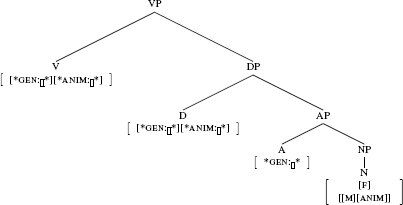 |
The assumptions (18a)–(18c) are crucial:
| (18) | a. | “a complex probe can probe past a simple feature to find a complex feature below it (Relativized Minimality: a subset does not intervene) |
| b. | a simple probe cannot probe past a complex feature to find a simple feature (Relativized Minimality: a superset intervenes) | |
| c. | a simple probe cannot be valued by a complex feature, which leads to a crash (feature copying requires matching of all features)” |
In the tree (17), the gender probe on A is valued by [f] on N and cannot be valued by [[m][anim]] on N due to (18c). D is valued by [[m][anim]] on N. This bypassing of A is permitted by condition (18a). V, finally, is valued by the previously valued D, i.e. we are dealing with an instance of cyclic agree (cf. Béjar & Rezac 2009). A “return” to grammatical gender by V by targeting [f] on N is preempted by Relativized Minimality/(18b). Moreover, if everything else is as in (17) but V bears a simplex gender probe, crash is inevitable, because complex gender on D cannot value V’s simplex gender probe as stated by condition (18c). Moreover, either gender feature on N cannot value the simplex gender probe on V, since condition (18b) prevents it: The complex gender probe on D induces an intervention effect. If gender on both D and A happens to be complex, we get biological gender throughout the DP. This is the derivation of the pattern (15)/(16).
Salzmann (2020) contends that this result only obtains under the DP-hypothesis, because only then is D closer to V than both A and N. The NP-hypothesis and the key assumption that all features of the head are present on the maximal projection would lead to the reverse result, i.e. it wrongly predicts the ungrammatical case in (16) in which a “switch” from a simplex gender feature on A to a complex gender feature on D and then again a grammatical/simplex gender on V obtains. This is so because simplex gender on AP, complex gender on D, and simplex gender on V can selectively target either target feature along the NP-projection – the analysis overgenerates.
2.2 Contributions adopting the NP analysis
Bruening (2020) sets out to show that three arguments against recent points of criticism against the DP-hypothesis (Bruening 2009, Bruening et al. 2018) lack force: N-to-D movement is not required in Shona, contrary to claims by Carstens (2017). Bosnian-Croatian-Serbian hybrid agreement within the nominal domain does not require the DP Hypothesis, contrary to claims by Salzmann (2018). And finally, patterns of conventionalized expressions suggest that selecting heads relate in a significant way with N, not D, suggesting a “close syntactic relation”, contrary to Salzmann (2018). We confine ourselves to hybrid agreement in BCS.
In BCS nouns like vladika ‘bishop’ are feminine as of their grammatical gender and masculine as of their natural gender. If agreement selectively targets either of these, this is referred to as hybrid agreement. The participial verb optionally agrees with the grammatical or the semantic gender (cf. the discussion of Salzmann 2020 before). However, NC-internally, there can be a “switch” from grammatical gender to biological gender as in (19). Once this happens, the verb has to agree in biological gender and cannot agree in grammatical gender:
- (19)
- On-i
- these-m.pl
- star-e
- old-f.pl
- vladike
- bishop.pl
- su
- are
- me
- me
- juče
- yesterday
- posetil-i/*-e.
- visited-m.pl/*f.pl
- ‘These old bishops visited me yesterday.’
Bruening (2020) offers an NP-based analysis, using a structured Gender feature on the head noun, which comprises both the Gr(ammatical) and the Sem(antic) gender feature, whose dominating node is not specified.
| (20) | 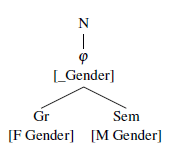 |
Bruening (2020) suggests that probing for Gender is in principle free to target either Gr Gender or Sem Gender. However, “as soon as something agrees with Sem, the features of Sem are copied onto the φ node. Thereafter nothing can look past φ and has to agree in the features copied there from Sem.” This stipulation ensures the observed pattern that once an element agrees (or concords) in semantic gender, there is no “returning” to grammatical gender. With these assumptions in place, Bruening (2020) offers a viable NP-based analysis which captures the BCS-pattern exemplified by (19).
Covering a broad range of different phenomena in the nominal domain, Machicao y Priemer & Müller (2021) specifically focus in prenominal genitives in German. They provide an HPSG-analysis and propose a structure in which an empty-headed, left-branching DetP occupies SPEC-NP:
| (21) | 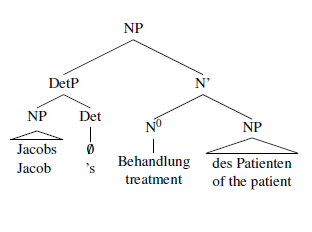 |
Machicao y Priemer & Müller (2021) point out that the analysis captures a number of properties, which characterize the construction more specifically, and NCs in general: Case can be locally assigned, thematic roles can be locally assigned, and properties of nominals can be selected from outside. According to the authors, dative possessor constructions in German provide empirical support for the approach,5 along the lines of (22):
- (22)
- Klaus
- Klaus.dat
- sein
- his.nom
- Händler
- dealer.nom
- hat
- has
- auch
- too
- noch
- still
- ein
- a
- paar
- pair
- ‘Klaus’ dealer also has some of it.’
In the dative possessor construction, the Det-head is realized by the possessive pronoun (sein in (22)). Machicao y Priemer & Müller (2021) provide corpus examples of recursive genitive possessors in German, which has been famously argued not to be possible:
- (23)
- […]
- Einschüsse
- bullet.holes
- auf
- on
- Peters
- Peter.gen
- Bruders
- brother.gen
- Harley
- Harley
- ‘bullet holes on Peter’s brother’s Harley’
Their analysis can accommodate these data, assuming that DetP can occupy the SPEC-position of the possessor-NP, which in turn is the complement of Det.
Van Eynde (2020) zooms in on certain determiners in Dutch which do not share values for φ-features and Case with the associated noun. wat ‘some’, veel ‘much/many’, meer ‘more’ and genoeg ‘enough’ exemplify these.
- (24)
- a.
- Er
- there
- is/*zijn
- is/*are
- nog
- still
- [wat/veel/meer/genoeg soep]
- {some/much/more/enough soup.sg}
- in
- in
- de
- the
- pot.
- pot
- ‘There is still some/much/more/enough soup in the pot.’
- b.
- Er
- there
- zijn/*is
- are/*is
- nog
- still
- [wat/veel/meer/genoeg aardappelen]
- {some/many/more/enough potato.pl}
- in
- in
- de
- the
- pot.
- pot
- ‘There are still some/many/more/enough potatoes in the pot.’
Subject verb agreement suggests that the noun heads the construction to the exclusion of these determiners. At the same time, Van Eynde (2020) suggests, the determiners are inherently singular as evidenced by constructions where they show up bare:
- (25)
- Er
- there
- is/*zijn
- is/*are
- nog
- still
- wat/veel/meer/genoeg
- some/much/more/enough
- in
- in
- de
- the
- pot.
- pot
- ‘There is still some/much/more/enough in the pot.’
In conjunction with other facts, this leads him to suggest an NP-based analysis couched within the HPSG paradigm. He adopts the functor analysis of determiners, where the determiner selects an unmarked nominal.
| (26) |  |
| (27) |  |
The representation (28b) is the analysis of (28a):
- (28)
- a.
- wat
- some
- aardappelen
- potato.pl
- b.
The NP-level inherits the head value from the noun and hence the relevant number information. “The determiner selects an unmarked nominal whose index it shares (3), but does not require that nominal to share its own agr[eement] value.” This way, the number features on the determiner and the noun can diverge.
Van Eynde (2020) ends his paper with a comparison with DP-based approaches. One core issue he raises concerns the sharing of features between D and its complement, NP:
“This sharing is not only more complex, it also lacks independent motivation, since heads normally do not share the case, number and gender of their NP complement. The verb in eats potatoes, for instance, does not share the number value of its NP complement, and the noun in the German die Vernichtung des Abendlandes ‘the annihilation the.gen evening.country.gen’ does not share the case of its genitive NP complement, nor its gender.”
He notes that while approaches based on the DP can handle the relevant facts, the NP-based one is simpler, requiring less machinery.
2.3 Beyond DP and NP
Driemel (2020) proposes a hybrid account of NCs in pseudo-noun incorporation (PNI) phenomena, suggesting that they involve hybrid categories which are partly nominal and partly verbal. She investigates PNI-constructions in Turkish, Tamil, Mongolian, and German, and focusses on the movement profiles of PNI-ed NCs. For these languages Driemel (2020) establishes the descriptive generalization that the movement properties and restrictions of NCs involved in PNI mirror the movement properties and restrictions of VPs. This forms part of the motivation to treat the relevant NCs as involving verbal features, assuming that syntactic computation is contingent on specific features.
Some cross-linguistic hallmarks of the PNI-construction are the lack of case marking and a restriction to low scope. These properties fall out from the verbal nature of PNI-ed arguments, Driemel (2020) claims. The fact that they enter into c-selectional relations with verbs, bear θ-roles, and can undergo adjectival modification betrays their nominal nature. Driemel (2020) suggests that these dual properties reflect different points in the syntactic derivation, the nominal characteristics preceding the verbal ones: The hybrid category undergoes a nominal, followed by a verbal derivational period.
Illustrating her approach by Tamil PNI in (29), the NC pustagam ‘book’ comprises lists of features, which exhibit a hierarchical order, a so-called feature stack. The verbal feature is borne by the D-head. Derivational steps follow the order of the features in the list such that the topmost feature must be discharged first, the second from top next, etc. The bulleted features represent features that drive (external and internal) Merge, following Müller (2009; 2011). The trees (30a)–(30d) represent the derivation of a transitive vP, grayed fonts represents discharged features; fonts between stars represent probes.
- (29)
- Ella
- all
- students-um
- students.nom.add
- pustagam∀∃,*∃∀
- book
- padi-c-aanga.
- read-pst.3pl
- ‘All students read a book.’
| (30) | a. | 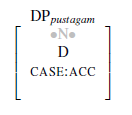 |
| b. | 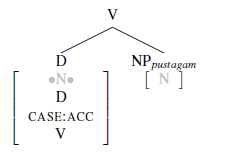 |
|
| c. | 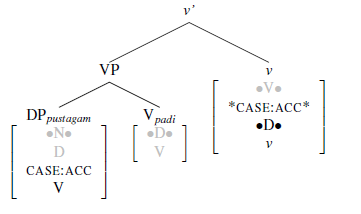 |
|
| d. | 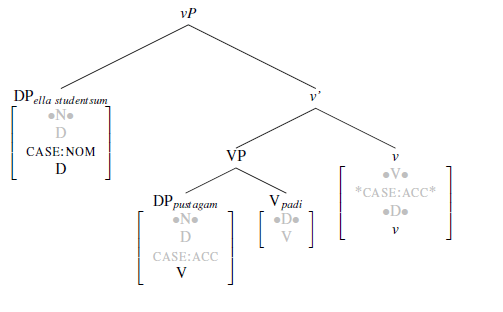 |
As the direct object DP still comprises a categorical verbal feature in its stack in the final tree, it can be attracted later in the derivation by a c-commanding head comprising a [•V•] feature.
Driemel (2020) points out that
“[the] categorial PNI account is superior to traditional DP/NP approaches, as they are not equipped to account for the cross-linguistic variation in movement patterns of PNI-ed arguments. By shifting the attention from a DP/NP contrast to an opposition between nominal and verbal properties of PNI-ed arguments, the theory paves the way for future cross-linguistic PNI studies that focus on the typology of movement possibilities and its potential to mimick movement patterns of other syntactic categories.”
If future cross-linguistic investigations consolidate a correlation between movement options of the two types of syntactic objects, this would truly be interesting. Beyond description it remains to be seen whether such a correlation is indeed reflective of shared categorial features between VPs and the NC.
Klockmann (2020) investigates quantificational expressions in English like a bunch, a few, a hundred. She subdivides these into pseudopartitives (a lot, a bunch, a ton), article-requiring quantifiers (a few, a couple, a hundred), and article-free quantifiers (three, many, several), the latter of which can feature an article when modified by an adjective (a surprising 30 …).
Based on a number of diagnostics, she argues that the article-like element which appears with these quantificational expressions is not an instance of an indefinite article or D. Instead, she proposes that the element is a default cardinality marker which is part of the hosting constituent QP, which itself is part of the containing NC:
| (31) | a. | 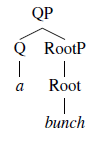 |
| b. |  |
|
| c. | 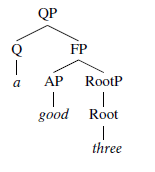 |
The article-like elements’ contingency on the quantifiers is thus accounted for, as are certain effects, like the absence of agreement by the verb with it, plural marking on some quantifiers (e.g. tons of), etc.
3 Attempting a synopsis
This section ties together points of discussion surrounding the proper syntactic analysis of NCs, distilling crucial theoretical assumptions and empirical arguments. We will discuss the relevance the papers have for syntactic theorizing. Moreover, we offer a broad, i.e. twofold, classification of the arguments. On the one hand, there are arguments that are based on issues of locality. On the other, there are arguments that are based on cooccurrence restrictions, features and categories. The arguments based on locality restrictions, in turn, involve agreement, the notion of projection, and θ-role assignment. Agreement, in turn, covers both formal agreement as well as “hybrid” agreement, which involves features like biological gender. Cooccurrence restrictions of elements within the NC and specific categorical features constitutes the second broad class. It will turn out that within each rubric, a mixed picture emerges showing that each phenomenon and diagnostic has been used by authors to argue for either NP or DP.
3.1 NC’s relevance for syntactic theory
NCs exhibit properties that are of central concern for syntactic theorizing. For example, by requiring a local relation to the head noun for thematic role assignment, prenominal possessors in English seem to be parallel in interesting ways to their clausal counterparts, cf. (32a) and (32b) (cf. Chomsky 1970):
| (32) | a. | John’s book |
| b. | John has a book. |
More specifically and as highlighted in the SC by Machicao y Priemer & Müller (2021) with corresponding examples from German, prenominal possessors have a syntactic function which needs to be fulfilled obligatorily and cannot be functionally substituted (as attempted in (33a)). A related issue is that the prenominal position plainly needs to be filled for singular count nouns in the relevant languages (33b) and by an appropriate element, call it a determiner category (cf. Stowell 1991, Longobardi 1994 on French, German and Italian, next to English):
| (33) | a. | *Mary reads book of John’s |
| b. | Mary reads the book of John’s |
That is, the argument structure intensively investigated in the clausal domain is mirrored NC-internally in interesting ways. Relatedly, NCs arguably constitute the canonical form of arguments that predicative elements require, and thus could perhaps inform our understanding of selectional relations. Their shape, categorical identity and featural constitution is thus of crucial importance to syntactic theory.
It remains to be understood why (33a) is deviant in the absence of an article or determiner-type category, and the DP-hypothesis has certainly contributed to highlighting and sharpening the problem. Tying the obligatory presence of articles in languages like English to an independent property of the grammar of the language is certainly a desirable move, not least because many languages most readily permit the omission of a determiner, i.e. the counterpart of the ungrammatical cases of (33a). For example, many Slavic languages like Russian (34), Polish, Bosnian-Croatian-Serbian, etc. fail to exhibit the English pattern:
- (34)
- … no
- but
- (èta)
- that
- mašin-a
- car-nom.sg.f
- byla
- was
- očen’
- very
- dorogoj
- expensive
- ‘but that car was very expensive’ (Czardybon 2017: 86)
In relation to such differences Bošković (2008) proposes that the typological split between article-less languages and those with article systems is captured by means of a parameter, correlating with other syntactic properties of the respective languages. Accordingly, article-less languages feature NPs without D-layer while article languages feature DPs. Furthermore, Bošković (2008) claims that being an NP-language is a precondition for the availability of Left Branch Extraction as illustrated by the example from Czech, (35). Again, DP-languages like English categorically disallow this, cf. (36), and fall under an NC-specific locality condition, the Left Branch Condition (37):
- (35)
- Jakoui
- which
- chte
- reads
- Petr
- Peter
- [ti knihu]?
- book
- ‘Which book does Peter read?’ (Corver 1990: 329–340)
| (36) | a. | *Whosei did you see [ti father]? | |
| b. | *Whichi did you buy [ti car]? | ||
| c. | *Thati he saw [ti car]. | ||
| d. | *Beautifuli he saw [ti houses]. | ||
| e. | *[How much]i did she earn [ti money]? | (Bošković 2005: 14) | |
| (37) | The Left Branch Condition (LBC), Ross (1986: 127) |
| No NP which is the leftmost constituent of a larger NP can be reordered out of this NP by a transformational rule. |
While a satisfactory account of such differences is still missing, they arguably constitute some of the core explananda for the syntactic analysis of NCs as they pertain to syntactic displacement, syntactic locality, islandhood and the like. As noted, such concerns are partly addressed in the SC.
Argument-verb agreement is another area which lies at the heart of syntactic theory (cf. Chomsky 2000 et seq). For example, failure by the verb to covary in person and number (roughly, φ) features with the corresponding ones on the noun as in (38) showcases the ways in which NCs contextually determine properties of clausal elements.
| (38) | a. | John has/*have a book. |
| b. | The kids have/*has a book. |
Understanding the nature and configurations of both Case- and φ-features is thus a prime concern for the theory of syntax – a challenge taken up by Bruening (2020), Salzmann (2020) and Van Eynde (2020) in the SC.
In an abstract sense, NC-internal agreement, or nominal concord, is an area addressed in the SC by Höhn (2020) and Iordăchioaia (2020). It is illustrated in the German example (39) where the article covaries in morphological case, gender and number with the head noun, which itself bears these features inherently:
- (39)
- mit
- with
- {dem/*die/*des}
- {the.dat.m.sg/the.nom.f.sg/the.gen.m.sg}
- Stein
- stone
- ‘with the stone’
What is the mechanism that underlies this syntactic covariation of features on the determiner? Höhn (2020) and Iordăchioaia (2020) provide possible answers based on the cross-linguistic investigation of a different construction (the adnominal pronoun construction as well as different types of gerunds), elucidating mechanisms of morphological realization and the role that different categories play in the process. Substantive elements that feature in NCs are also the concern of the contribution by Driemel (2020). She observes surprising parallels between the displacement patterns of NCs and VPs, raising the question if the featural make up of the latter could also play a role in the former. Again, such issues have been central to theoretical syntax at least since the definition of lexical categories in terms of the cross-classifications of primitive verbal and nominal features in Chomsky (1970).
Finally, the issue of structural complexity of units and elements in the NC is addressed. Are determiners phrasal? Are they homogenous at all? And if so, depending on our classification, how can we capture different co-occurrence restrictions of elements within NCs or NC regions? Rauth & Speyer (2021) explore such questions in dialectal variation and diachronic change of demonstratives in German.
3.2 A classification
Table 1 offers a survey of the criteria used to diagnose a specific approach.
When looking at columns 1, 2 and 4 of Table 1, it becomes apparent that empirical phenomena of the same class have been treated with differential analyses. Indeed, Bruening (2020) and Salzmann (2020) even use the same phenomenon to argue their case.
As for argument-verb agreement, all analyses more or less explicitly take projection of features in a phrase marker to be a prerequisite for the operation or relation.6 Conversely, according to a common assumption, argument verb agreement diagnoses projection and informs which of the two analyses is correct, the DP or the NP. Abstractly put, glossing over differences of implementation, and using an agree-type of relation (without committing ourselves), this looks as in the trees (40) and (41):
| (40) | 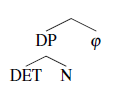 |
| (41) |  |
In both (40) and (41) the φ-set c-commands the NC. If DET in the NC projects as in (40), agreement will be with features of DET (or any other relevant feature in the nominal spine dominating N). If N in the NC projects as in (41), agreement will be with features of N. So far, so simple. But matters are not always this straightforward.
Do properties like biological sex have a bearing on grammar at all? And are the NC-phenomena of “hybrid agreement” in BCS specifically informing the syntactic analysis of NC? Such are the overarching issues underlying the empirical phenomena which Bruening (2020) and Salzmann (2020) are concerned with. The authors show that their specific approaches can capture the phenomena at hand without, however, addressing these rather vexing questions. On a descriptive level, independent complicated facts from grammatical gender and coordination in BCS raise the question whether the approaches by Bruening (2020) and Salzmann (2020) have any bearing on the debate of the proper syntactic analysis of NC. It could be that the facts the authors discuss have to be subsumed under or related to principles of argument verb agreement, which might be sensitive to semantic and grammatical properties of features and their linear order as in first or closest conjunct agreement, cf. the discussions by Despić (2016) and Matushansky (2021). Likewise, one can ask if the assumption by Van Eynde (2020) is justified that the class of determiners he investigates feature singular number at all. He rejects the possibility that in e.g. (42) the pronominally used determiner veel ‘much’ could be unspecified for number, arguing that then “it is expected to be compatible with a plural verb”:
- (42)
- Veel
- much
- hangt/*hangen
- depends/*depend
- af van
- of
- hoe
- how
- er
- there
- morgen
- tomorrow
- gestemd
- voted
- wordt.
- is
- ‘Much depends on how people will vote tomorrow.’
An alternative conclusion could be that the verb exhibits default (i.e. singular) inflection in the presence of an unspecified number controller. So the argument is not conclusive. As far as we can tell, the facts Van Eynde (2020) presents from R-pronouns likewise do not provide compelling arguments for an NP-approach.
In addition to subject verb agreement, morphologically manifested nominal concord between DET and N blurs a simple picture in that it is not clear which element controls agreement on φ, DET or N. If there are NC-internal dependencies, the picture is more nuanced. A common assumption (cf. Iordăchioaia 2020) is that features on D probe into D’s domain, the NP, receive a value and subsequent subject verb agreement relations target D(P), not N, i.e. D functions as an intermediary between φ and the corresponding controlling features on N. The search for a clearer criterion where DET-categories and N diverge with respect to some feature as pursued by Salzmann (2020) is thus well-motivated, complications like the ones mentioned above notwithstanding.
The articles by Klockmann (2020), Rauth & Speyer (2021), and Machicao y Priemer & Müller (2021) posit phrasal determiners, which are in principle compatible with either the NP or the DP, each of which provides a specifier position. In the fine-grained analysis Klockmann (2020) offers for different quantificational expressions in English within a DP-based approach, some principle must ensure that D remains an unpronounced category, cf. *a ton of {the/a} N, *a few {the/a} N, *three {the/a} N, *a surprising 30 {the/a} N. Rauth & Speyer (2021) remarks quoted above are on target and raise theory-internal questions with respect to restricting a system which in principle allows for multiple specifiers.7
The contribution by Höhn (2020) tacitly assumes a single NC-structure for the adnominal pronoun construction he broadly and impressively surveys. As far as we are concerned, bets are open whether that assumption is correct or whether an appositive structure is more adequate – a discussion which itself should be lengthy and requires careful argumentation. The problem of the third pronoun gap Höhn (2020) addresses is sure to appear very different when viewed from the appositive hypothesis.
4 Conclusion
The amount and quality of contributions that entered into the SC bears witness to the high relevance of the DP-/NP-debate, and shows that seemingly settled analytical issues require reevaluation and reconsideration, generating new observations and arguments in the process. The word cloud in Figure 1 features as a prominent and central term “analysis,” and this might not be a coincidence. The search for empirically adequate accounts and explanations informs theory, and theory, in turn, provides for tools of empirically grounded analysis.8
It is a truism that science raises novel questions as discoveries are made and solutions explored. More clarification on practically all the matters raised in this SC is required. Given that different facts from e.g. subject verb agreement argue for either NP or DP, there is an interpretation which none of the studies in the SC take into consideration. Maybe the facts suggest the fundamental conclusion that endocentricity should be given up or relaxed, i.e., the principle that a phrase is categorized by a unique head. Uncertainties of identifying the unique head (either N or D) would then provide indirect evidence for an exocentric approach to phrases or syntactic objects. If so, NCs are of even more fundamental significance to syntactic theorizing than hitherto thought. Of course, developing such an approach would require careful consideration.9 We hope to have shown that vigilant progress in this domain is worthwhile.
Notes
- Cf., e.g., Gil (2013) for an investigation of Riao Indonesian, which seemingly lacks a noun-verb distinction. [^]
- We borrow the term from Machicao y Priemer & Müller (2021), remaining neutral between the DP- and the NP-hypothesis. [^]
- We have weeded out some irrelevant words like since, outside, similarly, etc. [^]
- Pace influential work on the matter, cf. e.g. Bošković (2008). [^]
- Georgi & Salzmann (2011) show, on the other hand, that a DP-based approach to the construction is viable, avoiding the locality problem of thematic role assignment by assuming that the dative possessor is base generated in an NP-internal position, where dative case and θ are discharged. Subsequently, the possessor raises to SPEC-DP. [^]
- In Bruening’s (2020) approach this is couched within specific stipulations regarding the featural geometry of the noun, but the basic principle is the same that hierarchical proximity of a feature to the corresponding features on a probe defines the goal of agreement. [^]
- Cf. Epstein et al. (2020) for an attempt in this direction within the clausal domain. [^]
- Of course, this begs the question: Which theory? The field is rich with devices and framework-specific assumptions. But there is no escaping a framework and neutral point of view, we believe, as any description involves specific notions, each permitting or obstructing an insight or enhanced understanding. Entering this debate would necessitate a SC on its own. [^]
- A research industry of this type has been sparked in the wake of the recent labeling debate, cf. Chomsky (2013; 2015). Accordingly, there is no bottom up projection but rather a top down Minimal Search procedure seeking a prominent element in a set formed by Merge. Accordingly, both agreement and projection (labeling) involve the same overarching principle Minimal Search, such that both operations can perhaps be unified, cf. Epstein et al. (2018; 2020). If so, particular care is required when trying to use agreement as a diagnostic for labeling. The state of affairs is illustrated in a simplified fashion by (i):
In (ia), no feature is projected from either lexical item. Rather, the label of α is determined by a Labeling Algorithm, which peruses α and ambiguously finds DET and N in there. It is conceivable that matching and agreeing features within α are the actual target which φ finds. Of course, labeling is a procedure which differs from agreement in some ways (cf. Ke 2019 for a careful and formally explicit investigation): Agreement involves a controller and a target. Labeling is relational, too, in that there is a syntactic object, whose categorical identity is at stake and within which the Labeling Algorithm looks for a lexical item or a feature. Thus labeling is not characterized by a relation between two features but a relation between a bare set (the ‘target’) and a lexical item or feature (‘the controller’). It is nonetheless a possibility that the same principle applies to both of them as Ke (2019) shows (he argues that the algorithm finds only lexical items, not features, but questions remain). [^]
(i) a. 
b. {{DET, N}, φ }
Abbreviations
acc = accusative, add = additive, adv = adverb, anim = animate, dat = dative, dem = demonstrative, det = determiner, f = feminine, gen = genitive, m = masculine, nom = nominative, ptcp = participle, ptcl = particle, pst = past, pl = plural, refl = reflexive, sg = singular
Acknowledgements
The authors wish to thank Johan Rooryck for his patience, as well as detailed and helpful feedback on this paper. The usual disclaimers apply.
Competing interests
The authors have no competing interests to declare.
Author contributions
Both authors conceived the article. AB took the lead in writing the manuscript.
References
Abney, Steven. 1987. The English noun phrase in its sentential aspect. Cambridge, MA, MIT dissertation.
Béjar, Susana & Rezac, Milan. 2009. Cyclic agree. Linguistic Inquiry 40(1). 35–73. DOI: http://doi.org/10.1162/ling.2009.40.1.35
Bošković, Željko. 2005. Left branch extraction, structure of NP, and scrambling. In Sabel, Joachim & Saito, Mamoru (eds.), The free word order phenomenon: Its syntactic sources and diversity, 13–73. Berlin: Mouton de Gruyter.
Bošković, Željko. 2008. What will you have, DP or NP? In Proceedings of NELS 37.
Bruening, Benjamin. 2009. Selectional asymmetries between CP and DP suggest that the DP hypothesis is wrong. In MacKenzie, Laurel (ed.), University of Pennsylvania Working Papers in Linguistics, vol. 15, 26–35.
Bruening, Benjamin. 2020. The head of the nominal is N, not D: N-to-D Movement, Hybrid Agreement, and conventionalized expressions. Glossa: a journal of general linguistics 5(1). 1–19. DOI: http://doi.org/10.5334/gjgl.1031
Bruening, Benjamin & Dinh, Xuyen & Kim, Lan. 2018. Selection, idioms, and the structure of nominal phrases with and without classifiers. Glossa: A Journal of General Linguistics 3. 1–46. DOI: http://doi.org/10.5334/gjgl.288
Carstens, Vicki. 2017. Noun-to-determiner movement. In Everaert, Martin & van Riemsdijk, Henk (eds.), The Wiley Blackwell companion to syntax, vol. 5, 2758–2783. Somerset, NJ: John Wiley and Sons 2nd edn. DOI: http://doi.org/10.1002/9781118358733.wbsyncom120
Chomsky, Noam. 1970. Remarks on Nominalization. In Jacobs, Roderick A. & Rosenbaum, Peter S. (eds.), Readings in English Transformational Grammar, 184–221. Waltham: Ginn.
Chomsky, Noam. 2000. Minimalist Inquiries: The framework. In Martin, Roger & Michaels, David & Uriagereka, Juan & Keyser, Samuel Jay (eds.), Step by step: Essays in syntax in honor of Howard Lasnik, 89–155. Cambridge, Massachusetts: MIT Press.
Chomsky, Noam. 2013. Problems of Projection. Lingua 130. 33–49. DOI: http://doi.org/10.1016/j.lingua.2012.12.003
Chomsky, Noam. 2015. Problems of Projection: Extensions. In Domenico, Elisa Di & Hamann, Cornelia & Matteini, Simona (eds.), Structures, strategies and beyond – studies in honour of Adriana Belletti, 3–16. John Benjamins. DOI: http://doi.org/10.1075/la.223.01cho
Corver, Norbert. 1990. The syntax of left branch extractions: Tilburg University dissertation. DOI: http://doi.org/10.1515/9783110849998-004
Czardybon, Adrian. 2017. Definiteness in a language without articles – a study on Polish: Düsseldorf dissertation.
Despić, Miloje. 2016. Coordinating gender: What can coordinate structure agreement tell us about gender? Studies in Polish linguistics 11. 1–25.
Driemel, Imke. 2020. Pseudo-incorporation and its movement patterns. Glossa: a journal of general linguistics 5(1). 1–40. DOI: http://doi.org/10.5334/gjgl.1120
Epstein, Samuel D. & Kitahara, Hisatsugu T. & Seely, Daniel S. 2018. A Simpler Solution to Two Problems Revealed about the Composite Operation Agree. The Japanese Society for Language Sciences, Bunkyo Gakuin University.
Epstein, Samuel D. & Kitahara, Hisatsugu T. & Seely, Daniel S. 2020. Unifying Labeling under Minimal Search in “Single-” and “Multiple-Specifier” Configurations. Koyote Papers: Working Papers in Linguistics, Linguistic Theory at the University of Arizona 22. 1–11.
Georgi, Doreen & Salzmann, Martin. 2011. DP-internal double agreement is not double Agree: Consequences of Agree-based case assignment within DP. Lingua 121. 2069–2088. DOI: http://doi.org/10.1016/j.lingua.2011.07.010
Gil, David. 2013. Riau Indonesian: a language without nouns and verbs. In Rijkhoff, Jan & van Lier, Eva (eds.), Flexible word classes: Typological studies of underspecified parts of speech, 89–130. Oxford University Press: Oxford. DOI: http://doi.org/10.1093/acprof:oso/9780199668441.003.0004
Höhn, Georg F. K. 2020. The third person gap in adnominal pronoun constructions. Glossa: a journal of general linguistics 5(1). 1–43. DOI: http://doi.org/10.5334/gjgl.1121
Iordăchioaia, Gianina. 2020. D and N are different nominalizers. Glossa: a journal of general linguistics 5(1). 1–25. DOI: http://doi.org/10.5334/gjgl.1111
Ke, Alan. 2019. The syntax, semantics and processing of agreement and binding grammatical illusions: The University of Michigan, Ann Arbor, MI dissertation.
Klockmann, Heidi. 2020. The article a(n) in English quantifying expressions: A default marker of cardinality. Glossa: a journal of general linguistics 5(1). 1–31. DOI: http://doi.org/10.5334/gjgl.1151
Longobardi, Giuseppe. 1994. Reference and proper names. Linguistic Inquiry 25. 609–66.
Machicao y Priemer, Antonio & Müller, Stefan. 2021. NPs in German: Locality, theta roles, possessives, and genitive arguments. Glossa: a journal of general linguistics 6(1). DOI: http://doi.org/10.5334/gjgl.1128
Matushansky, Ora. 2021. Gender-fluid coordination. Talk given at the workshop Agreement in Multivaluation Constructions, Frankfurt, May 19–20, 2021.
Müller, Gereon. 2009. Ergativity, accusativity, and the order of Merge and Agree. In Grohmann, Kleanthes K. (ed.), Explorations of Phase Theory: Features and Arguments, 269–308. Berlin/New York: Mouton de Gruyter. DOI: http://doi.org/10.1515/9783110213966.269
Müller, Gereon. 2011. Constraints on Displacement: A phase-based approach. Amsterdam: John Benjamins. DOI: http://doi.org/10.1075/lfab
Nevins, Andrew. 2007. The representation of third person and its consequences for person-case effects. Natural Language & Linguistic Theory 25(2). 273–313. DOI: http://doi.org/10.1007/s11049-006-9017-2
Nevins, Andrew. 2011. Multiple agree with clitics: Person complementarity vs. omnivorous number. Natural Language & Linguistic Theory 29. 939–971. DOI: http://doi.org/10.1007/s11049-011-9150-4
Preminger, Omer. 2014. Agreement and its failures. Cambridge, MA: MIT Press. DOI: http://doi.org/10.7551/mitpress/9780262027403.001.0001
Puškar, Zorica. 2018. Interactions of gender and number agreement: Evidence from Bosnian/Croatian/Serbian. Syntax 21(3). 275–318. DOI: http://doi.org/10.1111/synt.12154
Rauth, Philipp & Speyer, Augustin. 2021. Adverbial reinforcement of demonstratives in dialectal german. Glossa: a journal of general linguistics 6(1). 1–24. DOI: http://doi.org/10.5334/gjgl.1166
Ross, John. 1986. Infinite syntax! Norwood, NJ: ABLEX.
Salzmann, Martin. 2018. Revisiting the NP vs. DP debate. Available at http://ling.auf.net/lingbuzz/003823.
Salzmann, Martin. 2020. The NP vs. DP debate. Why previous arguments are inconclusive and what a good argument could look like. Evidence from agreement with hybrid nouns. Glossa: a journal of general linguistics 5(1). 1–46. DOI: http://doi.org/10.5334/gjgl.1123
Stowell, Timothy. 1991. Determiners in NP and DP. In Leffel, Katherine & Bouchard, Denis (eds.), Views on phrase structure, 37–56. Dordrecht: Kluwer Academic Publishers. DOI: http://doi.org/10.1007/978-94-011-3196-4_3
Szabolcsi, Anna. 1983. The possessor that ran away from home. The Linguistic Review 3. 89–102. DOI: http://doi.org/10.1515/tlir.1983.3.1.89
Van Eynde, Frank. 2006. NP-internal agreement and the structure of the noun phrase. Journal of Linguistics 42(1). DOI: http://doi.org/10.1017/S0022226705003713
Van Eynde, Frank. 2020. Agreement, disagreement and the NP vs. DP debate. Glossa: a journal of general linguistics 5(1). 1–23. DOI: http://doi.org/10.5334/gjgl.1119
Zucchi, Alessandro. 1993. The language of propositions and events. Dordrecht: Kluwer Academic Publishers. DOI: http://doi.org/10.1007/978-94-015-8161-5


